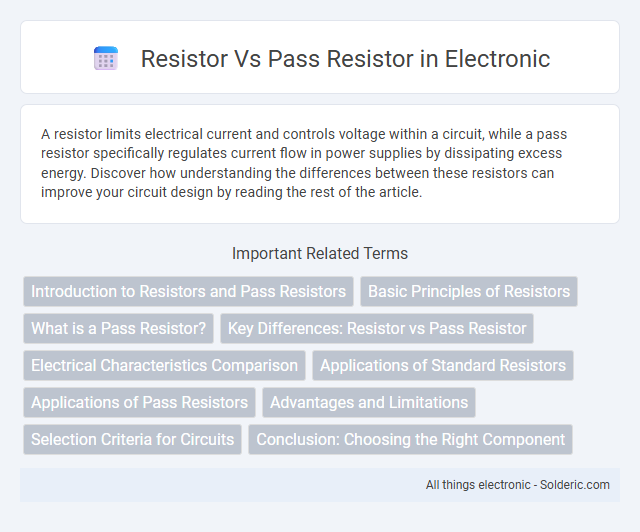A resistor limits electrical current and controls voltage within a circuit, while a pass resistor specifically regulates current flow in power supplies by dissipating excess energy. Discover how understanding the differences between these resistors can improve your circuit design by reading the rest of the article.
Comparison Table
| Aspect | Resistor | Pass Resistor |
|---|---|---|
| Function | Limits current, divides voltage in circuits | Controls current flow as a protective or limiting element |
| Common Use | Signal conditioning, biasing, and voltage division | Current sensing, protection in power circuits |
| Power Dissipation | Varies by type; generally low to medium power ratings | Usually higher power ratings to handle load current |
| Placement | Anywhere in the circuit as needed | Placed in series with load or circuit branch |
| Key Characteristic | Fixed resistance value | Stable resistance with low tolerance for accurate current measurement |
| Example Component | Carbon film, metal film resistor | Shunt resistor, precision low-ohm resistor |
Introduction to Resistors and Pass Resistors
Resistors regulate electrical current by providing a precise amount of resistance, essential for controlling voltage and current in circuits. Pass resistors function specifically as current-limiting devices protecting sensitive components by dissipating excess power during fault conditions. Understanding the distinctions between standard resistors and pass resistors is crucial for designing reliable electronic systems with optimized thermal management and circuit protection.
Basic Principles of Resistors
Resistors regulate electrical current by providing a specific amount of resistance, converting electrical energy into heat to control circuit flow. A pass resistor, typically used in voltage regulators or current limiters, allows controlled current flow while maintaining device protection by dissipating power effectively. Understanding the material composition, resistance value, and power rating is essential for selecting the right resistor type to ensure circuit stability and performance.
What is a Pass Resistor?
A pass resistor is a specialized resistor used primarily in voltage regulator circuits to control and limit current flow, functioning as part of the pass element that dissipates power. Unlike standard resistors, pass resistors are designed to handle higher power loads and thermal stress, ensuring stable voltage output. Understanding your circuit's power and thermal requirements helps determine if a pass resistor is necessary for reliable operation.
Key Differences: Resistor vs Pass Resistor
Resistors regulate current by providing fixed resistance, while pass resistors specifically control current flow within power supply circuits by dissipating excess voltage as heat. Key differences include their application scope and power rating; pass resistors typically handle higher power dissipation to protect sensitive components, unlike standard resistors used for general current limiting or voltage division. Understanding these distinctions ensures your circuit maintains optimal performance and safety.
Electrical Characteristics Comparison
Resistors and pass resistors differ significantly in electrical characteristics, where standard resistors primarily provide fixed resistance to limit current flow, while pass resistors, often used in voltage regulators, handle varying current loads with low power dissipation. Pass resistors typically exhibit lower resistance values and higher power ratings to efficiently manage dynamic electrical stresses in circuits. Your choice between the two depends on the specific application requirements regarding current stability and thermal management in electronic designs.
Applications of Standard Resistors
Standard resistors are commonly used in electronic circuits for current limiting, voltage division, and signal conditioning due to their precise resistance values and reliability. They play a crucial role in applications such as biasing active components, setting operating points, and protecting components from excessive current. Unlike pass resistors, which handle higher power dissipation in voltage regulation circuits, standard resistors are ideal for general-purpose applications with lower power requirements.
Applications of Pass Resistors
Pass resistors are commonly utilized in voltage regulation circuits to control current flow and dissipate power as heat, ensuring stable output voltage levels. They are integral in linear power supplies, where they function to drop excess voltage and protect sensitive components from voltage spikes. Your electronic projects benefit from pass resistors by providing reliable current limiting and preventing damage to downstream circuitry.
Advantages and Limitations
A resistor offers simplicity and precise voltage control with minimal noise, making it ideal for basic current limiting and signal conditioning applications. Pass resistors, used in linear regulators, provide smoother voltage regulation and better heat dissipation but may introduce higher power loss and reduced efficiency under heavy loads. Choosing between the two depends on balancing design efficiency, thermal management, and the required electrical performance.
Selection Criteria for Circuits
Selection criteria for resistors versus pass resistors depend on power dissipation, tolerance, and application load requirements. Standard resistors suit low-power signal applications, while pass resistors handle higher current in voltage regulator circuits, requiring low resistance with high wattage ratings. Thermal stability, noise level, and precision values also influence the choice to ensure optimal circuit performance and reliability.
Conclusion: Choosing the Right Component
Selecting the right component between a resistor and a pass resistor depends on the application's power dissipation, voltage drop requirements, and thermal management capabilities. Standard resistors suit low-power, signal-level circuits, while pass resistors are designed for higher current loads and continuous operation in power regulation contexts. Evaluating parameters like resistance value, power rating, and package type ensures optimal performance and reliability in electronic designs.
resistor vs pass resistor Infographic

 solderic.com
solderic.com